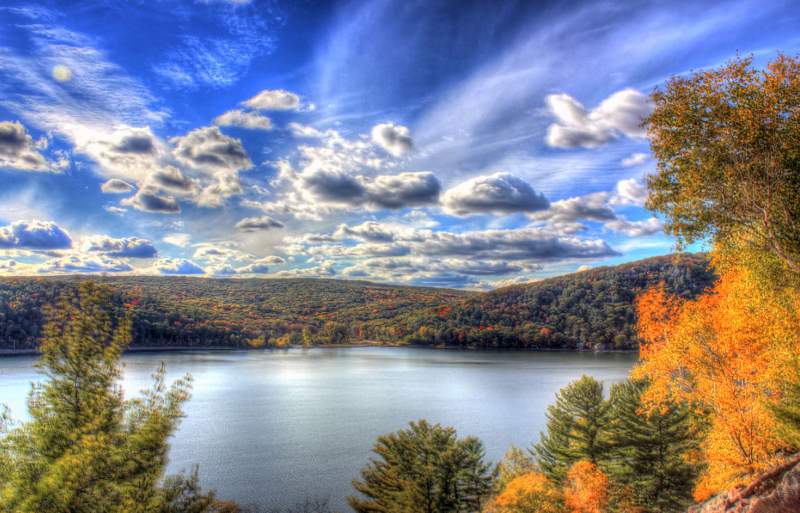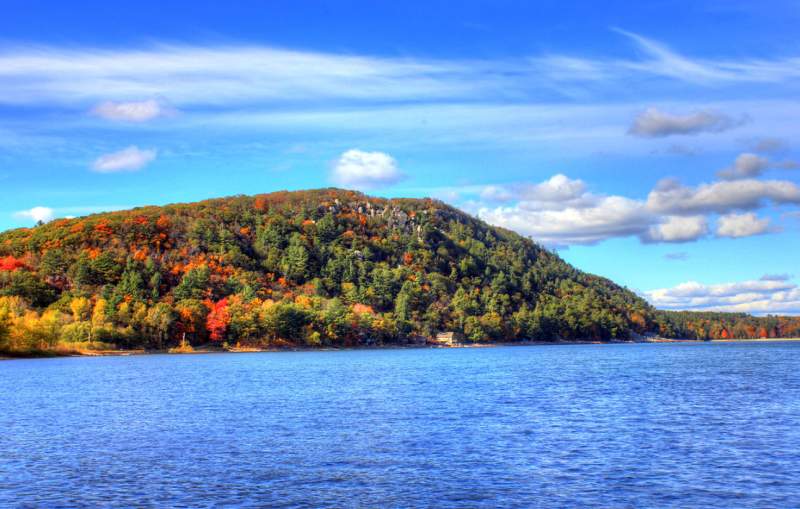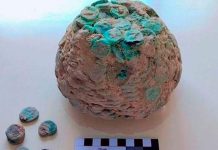On the three sides of Devils Lake crumbled quartzite bluffs were formed by the rushing water of an extinct river. During the Wisconsin glaciation, the valley around Devils Lake was originally an arm of the Wisconsin River.
The glaciers covering much of the area melted and eventually diverted the river by pushing up two moraines of rock and soil that landlocked the remaining water. The spring-fed Devils Lake is “trapped” between quartzite bluffs and glacial “plugs.” If there hadn’t been a series of Ice Ages, the Wisconsin River and Devils Lake would have remained in their pre-glacial courses.
Today, the lake varies from 40 to 50 feet and 12 to 15 meters in depth. Native Americans in central Wisconsin highly revere Devil’s Lake and have told stories for generations about how it was created. The Winnebago, now called Ho Chunk, believed that water spirits who lived in the lake’s depths battled powerful thunderbirds in the sky and, in so doing, threw up boulders and cliffs. The destruction was caused by the lightning bolts of aerial thunderbirds versus the spouts of water spirits while fighting each other.
The Devils Lake is enclosed by enormous fallen rock piles, the remains of legendary battles. The Winnebago were the most significant tribe in the area. Although the Sauk, Fox, and Kickapoo people also visited the lake, it is not known if they were there. In the summer months, pilgrims making religious offerings cautiously approached the lake on a sacred journey.
As the tribes gathered in large numbers, ceremonial activities were centered around the effigy mounds on the north and southeastern shores. Devil’s Lake’s north shore has three types of mounds: those in the form of animals, the “true” effigy mounds; those that look like ridges, the linear mounds; and those that look like giant chocolate drops, the round or conical mounds. On the north shore are four effigy mounds, two linear mounds, and two conical mounds, attesting to their esteemed value as a ritual site.
On the south shore near the eastern cliffs is a lone bird-shaped mound, the only mound in the area known to contain a human skeleton. It is possible that this 150-foot and 45-meter-long “fork-tailed” bird effigy may also represent a “bird man,” combining the wing characteristics of a bird and the legs of a human. In all likelihood, the bird mound and the clusters of mounds on the north shore were sacred places for ceremonies and rites. Among the Winnebago, the lake was called Tamahcunchukdah, which means “Sacred Lake” or “Spirit Lake.”
Devils Lake is the mistranslated name of the spring-fed lake said by the Woodland tribes to contain underwater supernatural spirits. Some sources contend that the effigy-building tradition lives on in the Siouan-speaking Winnebago tribe of southern Wisconsin. Others argue that the practice was lost at least 750 years ago and has disappeared. Almost all researchers agree that around the time of contact with white settlers, most Midwestern Indians continued to excavate burial graves for the recently deceased into previously existing mounds. This is similar to the way newly constructed graves are added to a family plot in cemeteries today.
But as Manifest Destiny mandated the spread of white settlers westward, almost every tribe in the last mound-building regions was coerced or forced to vacate their land. Most Winnebago were removed from their homeland by a treaty in 1832 to live in Nebraska, and whatever bit was recorded of their unique customs remains vague. By 1838, the Winnebago had relinquished all their lands east of the Mississippi River. Through neglect, prejudice, and contempt for Native American traditions, what may have survived the effigy-building tradition was lost to history.
Effigy Indians left their marks on the land, which was rediscovered by Euro-American settlers several hundred years ago. The effigy mound-building region of Wisconsin, eastern Iowa, and northern Illinois seemingly centers on Devil’s Lake. Effigy mound groupings show uneven distribution throughout the effigy region; however, some general patterns exist. With an affinity for natural beauty, effigy builders typically choose vista points overlooking water bodies for their creations.
Madison, Wisconsin’s lake region, once contained over 100 effigies among 1,000 estimated mounds, and several surrounding lakes showed similar densities. Other areas of remarkable effigy group densities occur along the Fox River and the lower Wisconsin River, particularly near the Mississippi confluence. Water spirit effigies, mostly lizards, predominate in the eastern part of the state near Lake Michigan. Land animals, especially bears, represent the earth and can be found mostly in western Wisconsin, especially alongside the Mississippi River.
Bird mounds signify air and are most commonly found atop scenic valley bluffs or lake-view prominences. The Devil’s Lake effigies represent water spirits, earth animals, and birds, congruent with the Winnebago legend of the lake’s destructive creation. Wanton demolition by the farmers’ plow, ambitious developers, and souvenir seekers has decimated this once-dense concentration of priceless artifacts. More than a century ago, the mounds were plowed down by farmers and regarded as obstacles to cultivation. Records at the State Historical Society of Wisconsin indicate that around 4,000 mounds remain in the state.
This represents only three to four of the original mounds found throughout the dairy state. The remaining mounds, now protected by the 1985 Burial Sites Preservation Law, are a small fraction of what was once a common characteristic of the Wisconsin landscape. Getting to Devils Lake Devils Lake State Park is located about an hour north of Wisconsin’s capital, Madison, and three miles (5 km) south of Baraboo on State Highway 33.
Several effigy mounds are preserved on both shores of the lake. There is a self-guided “Indian Mounds Nature Tour” pamphlet available at the Ranger’s Station or the Nature Center. There is a nominal recreation fee for motorists entering the State Park. There are a lot of linear formations and effigy mounds on the northern shore of Devils Lake.
Read More: Devils Postpile National Monument










